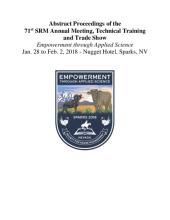/ library resources
Showing items 1 through 9 of 26.Rangelands in north Africa and the near east in general provide numerous goods and services that have great economic, social, cultural, and biological values.
Numerous studies have been conducted that evaluate the utility of remote sensing for monitoring and assessing vegetation and ground cover to support land management decisions and complement ground measurements.
Goat browsing can be used as an alternative brush management option for redberry (Juniperus pinchotii Sudw.) and ashe (Juniperus asheii Buch) juniper instead of more expensive and invasive brush control methods, assuming consumption of juniper does not adversely affect the marketability of offspr
Rapidly increasing demand for food, fiber, and fuel together with new technologies and the mobility of global capital are driving revolutionary changes in land use throughout the world.
A critical challenge for range scientists is to provide input to management decisions for land units where little or no data exist.
The Gunnison sage-grouse (GUSG) is an iconic species recently proposed for protection under the Endangered Species Act (ESA).
A key goal in land management is to prevent ecosystem shifts that affect human well-being.
Although human influence across rural landscapes is often discussed, interactions between the native, natural systems and human activities are challenging to measure explicitly.
Balancing the number of grazing animals with the level of plant resources is a core issue in grazing management. Complete, full-coverage vegetation surveys are often used for this purpose, but these are expensive undertakings.
Pagination
Land Library Search
Through our robust search engine, you can search for any item of the over 73,000 highly curated resources in the Land Library.
If you would like to find an overview of what is possible, feel free to peruse the Search Guide.


